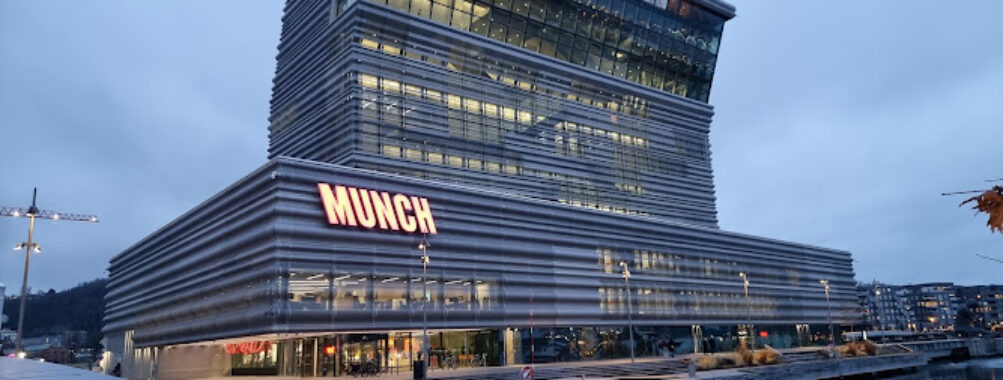
Munch
“`html
Table of Contents
Description
There’s something magnetic about the Munch Museum in Oslo. Maybe it’s the haunting stare of The Scream—that universal symbol of existential panic—or maybe it’s how the place feels like stepping into the mind of Edvard Munch himself. The museum holds more than 26,000 of his works, from paintings and sketches to prints, photographs, and even his personal belongings. You can almost sense his presence in the air—like he just walked out of the room to grab a coffee and might be back any minute.
What I love most about the Munch is how it doesn’t just show art—it tells stories. You see the evolution of a man who painted his emotions raw. Some rooms are heavy, sure, but others are surprisingly hopeful. And if you’ve ever stood in front of The Scream in person, you know it’s not just about fear—it’s about being seen. The museum’s layout makes it easy to wander without rushing, letting you breathe between the intensity of his brushstrokes. It’s modern, airy, and somehow intimate despite the scale.
The staff here really know their stuff too. They’re friendly and genuinely excited to talk about Munch’s life, his techniques, and his quirks. And there’s something wonderful about seeing kids pointing at the paintings, trying to mimic the faces—it makes the whole experience feel alive. The museum manages to balance being a serious art space with being welcoming to families and casual visitors. You don’t have to be an art historian to appreciate what’s going on here. Just bring your curiosity.
Key Features
- Over 26,000 original works by Edvard Munch, including paintings, prints, drawings, and sculptures.
- Permanent and rotating exhibitions that explore Munch’s influence on modern art and culture.
- Live performances and interactive experiences that bring his art to life in unexpected ways.
- Onsite restaurant and café serving Norwegian-inspired dishes with stunning views of Oslo’s waterfront.
- Free Wi-Fi throughout the building for those who can’t resist sharing a moment (or a selfie) with The Scream.
- Wheelchair accessible entrances, restrooms, and parking—accessibility is clearly a priority here.
- Family-friendly facilities, including changing tables and kid-oriented activities that make art approachable for all ages.
Best Time to Visit
If you’re not a fan of crowds (and who really is?), aim for weekday mornings. The museum opens early enough that you can have a few quiet moments with Munch’s works before the tour groups roll in. I once went on a rainy Tuesday in September—it was perfect. The gray Oslo skies outside somehow made the paintings feel even more alive.
Summer is the busiest, of course, but also the most convenient if you’re exploring other attractions nearby. The light lasts forever that time of year, which means you can spend hours inside and still catch the golden hues over the fjord afterward. Winter visits have their charm too—the museum’s warm lighting and cozy café make for a great escape from the cold. Honestly, there’s no bad time to go, but if I had to pick, late spring or early autumn feels just right.
How to Get There
Getting to the Munch Museum is straightforward, even if you’re new to Oslo. The public transport system here is efficient and clean (a rare combo in many cities). You can hop on a tram or bus that stops just a short walk away. For those staying in the city center, it’s a pleasant stroll—especially if you take the route along the waterfront.
If you’re driving, there’s accessible parking nearby, though it can fill up fast on weekends. Personally, I prefer walking or biking—it gives you time to soak in the city’s atmosphere before diving into Munch’s world. Plus, Oslo’s bike paths are excellent. And if you’re coming from the airport, the train ride into the city is scenic and quick. Once you arrive, the museum’s striking modern architecture makes it impossible to miss.
Tips for Visiting
Here’s the thing—don’t rush. The Munch isn’t a place you “check off” your list. It’s a space that rewards lingering. Take time to sit on the benches scattered throughout the galleries. Watch how other visitors react to the art—it’s fascinating. Some stand in silence, others whisper, and a few just stare like they’re trying to decode Munch’s thoughts.
If you can, join one of the guided tours. They’re not your typical dry art lectures; the guides weave in stories about Munch’s life—his heartbreaks, his obsessions, his struggles with fame. It adds layers to the experience. And don’t skip the upper floors; the views of Oslo from the large glass windows are worth the climb alone.
Bring a notebook or sketchpad if you’re the creative type. I once spent an hour just sketching the people around me instead of the paintings—it felt like connecting with Munch’s spirit in my own small way. And yes, the museum shop is fantastic. It’s not just postcards and magnets; there are art books, prints, and even quirky souvenirs that make perfect gifts.
Oh, and one more thing—plan a meal at the restaurant. The food is surprisingly good (try the fish soup if it’s on the menu). Sitting there with a cup of coffee, looking out over the city after immersing yourself in Munch’s world—it’s one of those small, perfect travel moments you’ll remember long after you’ve gone home.
The Munch Museum isn’t just about art—it’s about emotion, memory, and human connection. Whether you’re an art lover, a casual traveler, or someone just curious about that screaming face you’ve seen a thousand times online, this place has a way of getting under your skin in the best possible way. Go with an open mind, take your time, and let Munch’s world unfold around you.
“`
Location
Places to Stay Near Munch
Find and Book a Tour
Explore More Travel Guides
No reviews found! Be the first to review!